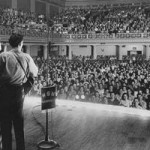New Harmonies exhibition explores the roots of American music
Hartsville and Walterboro are the last South Carolina stops on the Smithsonian Institution’s traveling exhibition, “New Harmonies: Celebrating American Roots Music.”
New Harmonies explores Americans’ creative expression through music — music known by names such as the blues, country western, folk ballads and gospel. The instruments vary from fiddle to banjo to accordion to guitar to drum, but a drum in the hands of an African sounds different than one in the hands of a European or an American Indian. Yet all the rhythms merge, as do the melodies and harmonies, producing completely new sounds — new music.
Through photographs, recordings, instruments, lyrics and artist profiles, the exhibition explores the distinct cultural identities of music that shaped America and made this country the birthplace of more music than any place on earth. The story is full of surprises about familiar songs, histories of instruments, the roles of religion and technology, and the continuity of musical roots from “Yankee Doodle Dandy” to the latest hip hop CD.
New Harmonies is on exhibition at the Black Creek Arts Council in Hartsville until Nov. 11. The exhibition then moves to the Colleton County Museum and Farmers Market in Walterboro from Nov. 17 – Jan.5. Marlena Smalls and the Hallelujah Singers will perform at the opening Nov. 17.
Developed as part of the Museum on Main Street program, New Harmonies is designed especially for small museums and rural audiences that lack regular access to traveling exhibitions. New Harmonies is sponsored in South Carolina by the Humanities CouncilSC.
Photos (top, left to right): Blues “harpist” James Cotton. Spanish American musicians in Taos, New Mexico, 1940. American Indian Powwow, 2006.
(bottom, left to right): Folk musicians, New York City, 1960s. Nathan Williams and his Zydeco Chas Chas, Louisiana. Roy Acuff at the Grand Ole Opry, 1939.
Via: Humanities CouncilSC, Museum on Main Street







